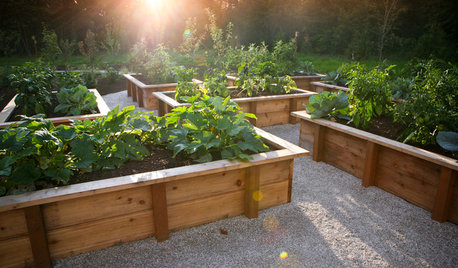Remove lawn for a raised bed??
moo_sue
18 years ago
Related Stories

GARDENING GUIDES8 Materials for Raised Garden Beds
Get the dirt on classic and new options for raised vegetable and plant beds, to get the most from your year-round garden
Full Story
GARDENING AND LANDSCAPINGRaised Beds Lift Any Garden
From good old-fashioned wood garden boxes to modern metal troughs, raised beds can make any landscape space look great
Full Story
FARM YOUR YARDHow to Build a Raised Bed for Your Veggies and Plants
Whether you’re farming your parking strip or beautifying your backyard, a planting box you make yourself can come in mighty handy
Full Story
FRONT YARD IDEASBefore and After: Front Lawn to Prairie Garden
How they did it: Homeowners create a plan, stick to it and keep the neighbors (and wildlife) in mind
Full Story
GARDENING GUIDESSmall Gem Lawns: More Impact From Less Grass
Instead of letting the lawn sprawl, make it a shapely design element in your yard. You’ll reap benefits both practical and aesthetic
Full Story
SAVING WATERHouzz Call: Are You Letting Go of Your Lawn?
Many facing a drought are swapping turf for less thirsty plantings. If you’re one of them, we’d like to hear about it
Full Story
LANDSCAPE DESIGNGet Along With Less Lawn — Ideas to Save Water and Effort
Ditch the mower and lower your water bill while creating a feast for the eyes with diverse plantings and gathering places
Full Story
BEFORE AND AFTERSSee 6 Yards Transformed by Losing Their Lawns
Wondering whether a turf lawn is the best use of your outdoor space? These homeowners did, and they found creative alternatives
Full Story
LANDSCAPE DESIGN15 Great Ideas for a Lawn-Free Yard
End the turf war for good with hardscaping, native grasses and ground covers that save water and are easier to maintain
Full Story
GREAT HOME PROJECTSHow to Replace Your Lawn With a Garden
New project for a new year: Lose the turfgrass for energy savings, wildlife friendliness and lower maintenance
Full StoryMore Discussions


tapla (mid-Michigan, USDA z5b-6a)
moo_sueOriginal Author
Related Professionals
Frisco Landscape Contractors · Brookfield Landscape Contractors · Englewood Landscape Contractors · Huntington Landscape Contractors · Munster Landscape Contractors · Ramsey Landscape Contractors · Rockville Landscape Contractors · San Rafael Landscape Contractors · Seven Hills Landscape Contractors · Tehachapi Landscape Contractors · West Haverstraw Landscape Contractors · East Norriton Landscape Contractors · Baileys Crossroads Landscape Contractors · Springfield Window Contractors · Webster Groves Window Contractorstapla (mid-Michigan, USDA z5b-6a)
meldy_nva
moo_sueOriginal Author
tapla (mid-Michigan, USDA z5b-6a)
Skybird - z5, Denver, Colorado
meldy_nva
tapla (mid-Michigan, USDA z5b-6a)
moo_sueOriginal Author
tapla (mid-Michigan, USDA z5b-6a)